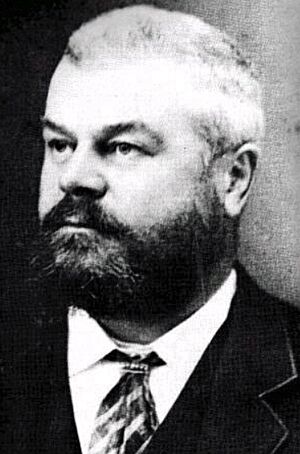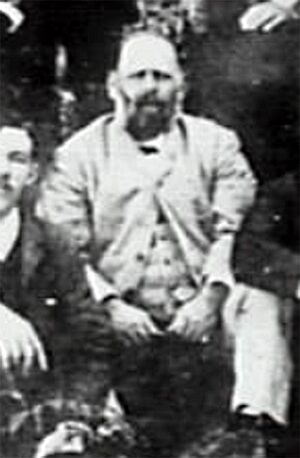Bulli Jetty facts for kids
Quick facts for kids Bulli Jetty |
|
|---|---|

Bulli Jetty circa 1900 showing the coal trucks and steam train
|
|
| Coordinates | 34°19′46.740″S 150°55′38.377″E / 34.32965000°S 150.92732694°E |
| Characteristics | |
| Total length | over 800 feet (240 m) |
The Bulli Jetty was a long pier built at Sandon Point in Australia. It was first built in 1863 and was used until 1943. Its main job was to help the Bulli Coal Company transport coal. Coal from the Bulli mine was loaded onto ships at the jetty and then sent to other places around the world.
A famous writer, D. H. Lawrence, visited the area in 1922. He lived close to the jetty and described it. He said it looked like a long, tall pier sticking out into the sea. It had tracks for small red coal trucks that could tip their loads. Most of the time, the jetty was quiet and empty. But sometimes, it would get busy. Steamships would arrive, and a small train would chug along the pier. Little men would move across the skyline, and black dust would fill the air around the ships.
Contents
History of the Bulli Jetty
The Bulli Jetty was first built at Sandon Point in 1863. It was over 200 meters (about 650 feet) long. William Weaver, an engineer for the Bulli Coal Company, was in charge of building it.
In 1867, a big storm hit the area. Much of the jetty was washed away, and four men working on it sadly lost their lives. Over the next 20 years, the jetty needed many repairs because of storm damage. Around 1890, it even closed for several years.
New Ownership and Improvements
In 1894, a businessman named George Adams bought the Bulli Coal Company. He decided to rebuild the jetty. He made it about 30 meters (about 100 feet) longer. He also made it taller so that bigger coal ships could load safely. A big improvement was adding electric lights to the jetty. This was a very modern feature at that time!
George Adams also built a large house called "Sandon Cottage" near the jetty. He would stay there sometimes and even invite important people, like politicians, to visit.
Strange Collapse and Storms
In April 1907, something very strange happened. The weather was perfectly calm, but a large part of the jetty suddenly collapsed into the sea. A newspaper reported that it happened "without the slightest warning." One worker had just moved away from that section moments before it fell.
Two months later, a fierce storm destroyed the remaining part of the jetty that was still standing. It took almost two years to repair the jetty after these incidents. In 1912, another major storm caused more damage, which also took a long time to fix.
The jetty was damaged again in 1943 and was finally left unused. Later storms caused even more damage to its support poles. Fishermen sometimes used the old jetty, but no more coal mining operations happened there.
People Who Worked at the Jetty
Many people worked hard at the Bulli Jetty over the years. One of the first managers was Alexander Spence Artis. He started working at the jetty when he was 27, soon after it opened. He stayed there for 24 years until he retired. Artis was born in England and became a skilled sailor. He arrived in Sydney in 1863 and later came to Bulli. He found work at the jetty and eventually became its manager.
Another important manager was James Owers (1862-1939). He started working at the jetty around 1890. He had been a sailor on a coal ship called the Woonona, which regularly visited Bulli. Owers worked at the jetty for over 40 years, eventually becoming the manager.
Images for kids






